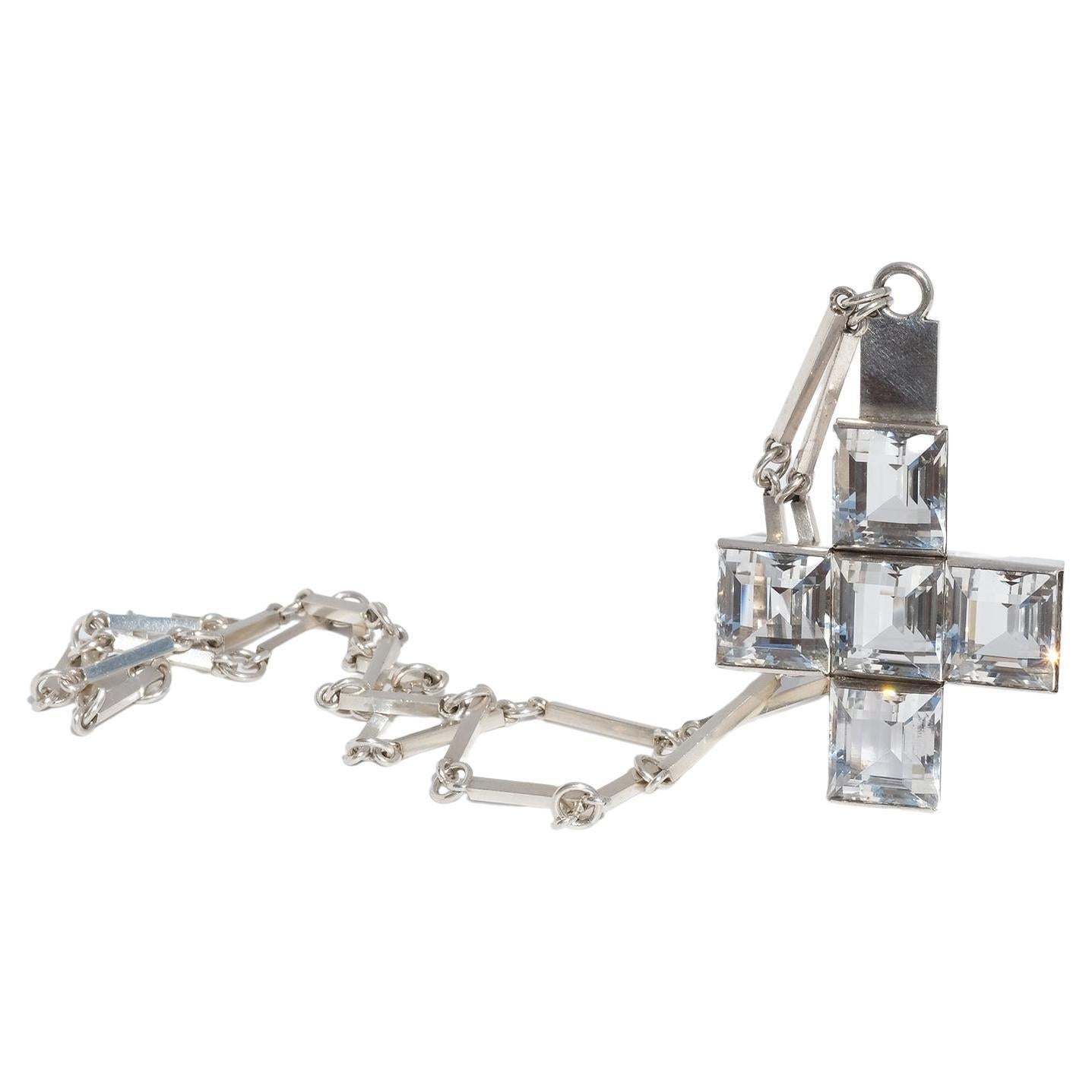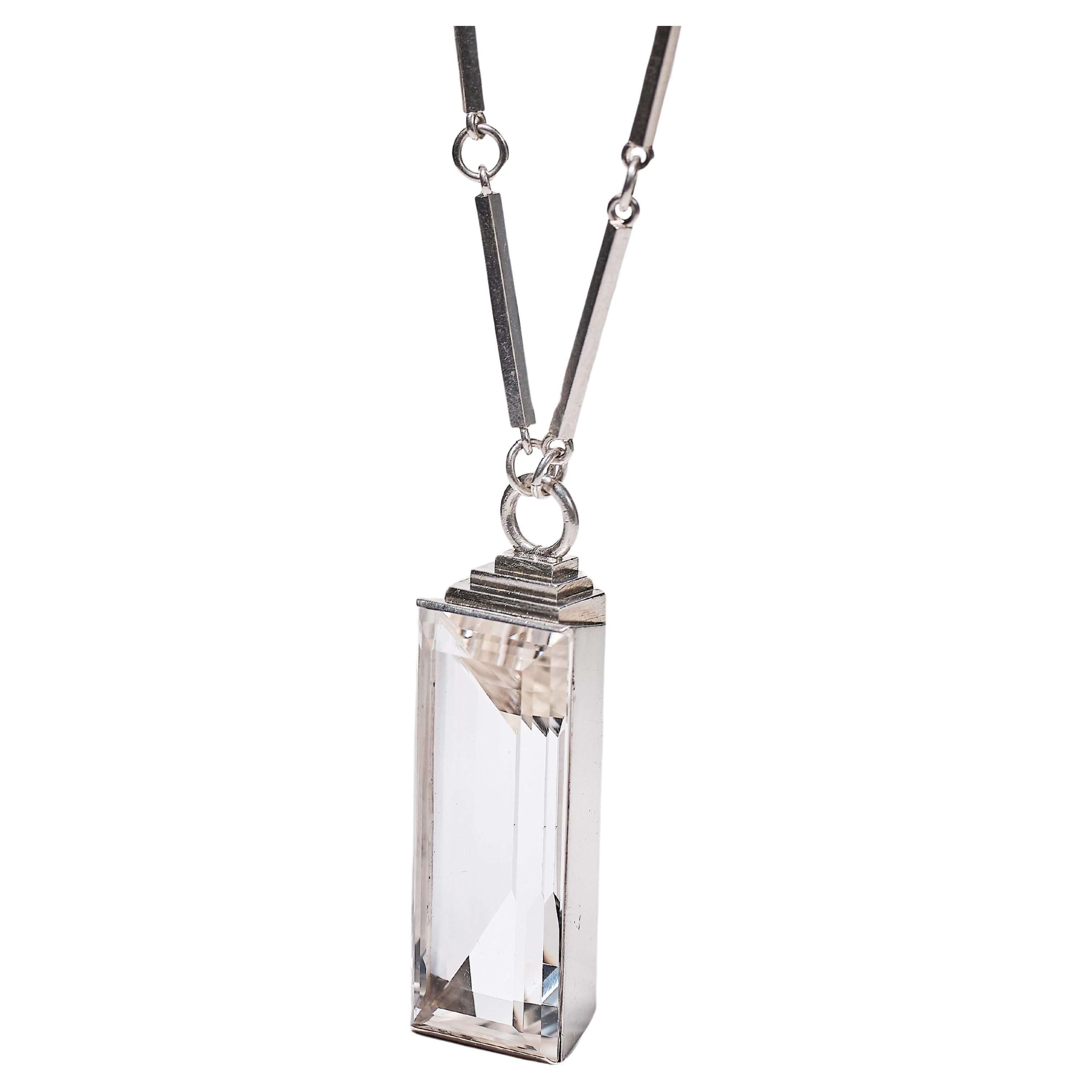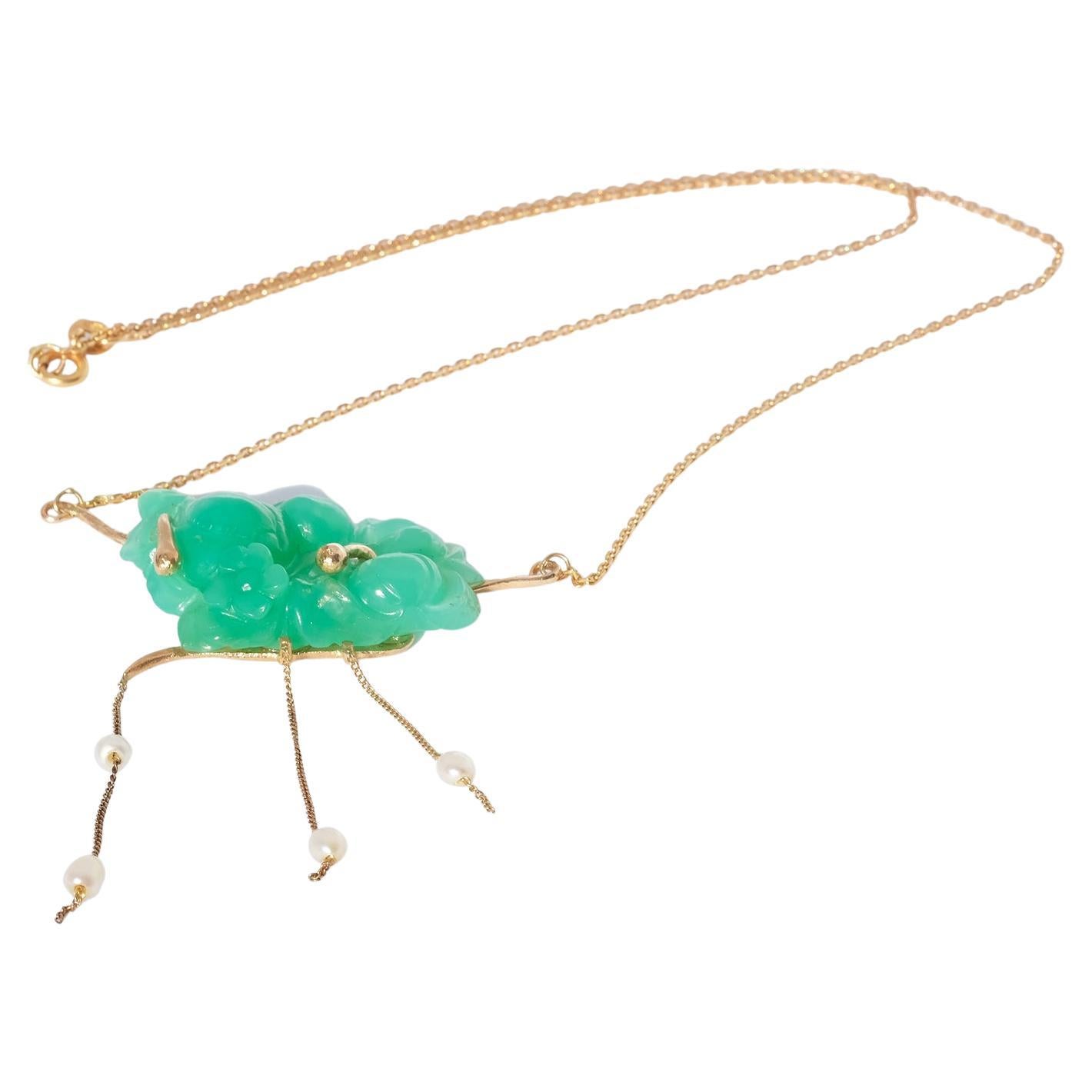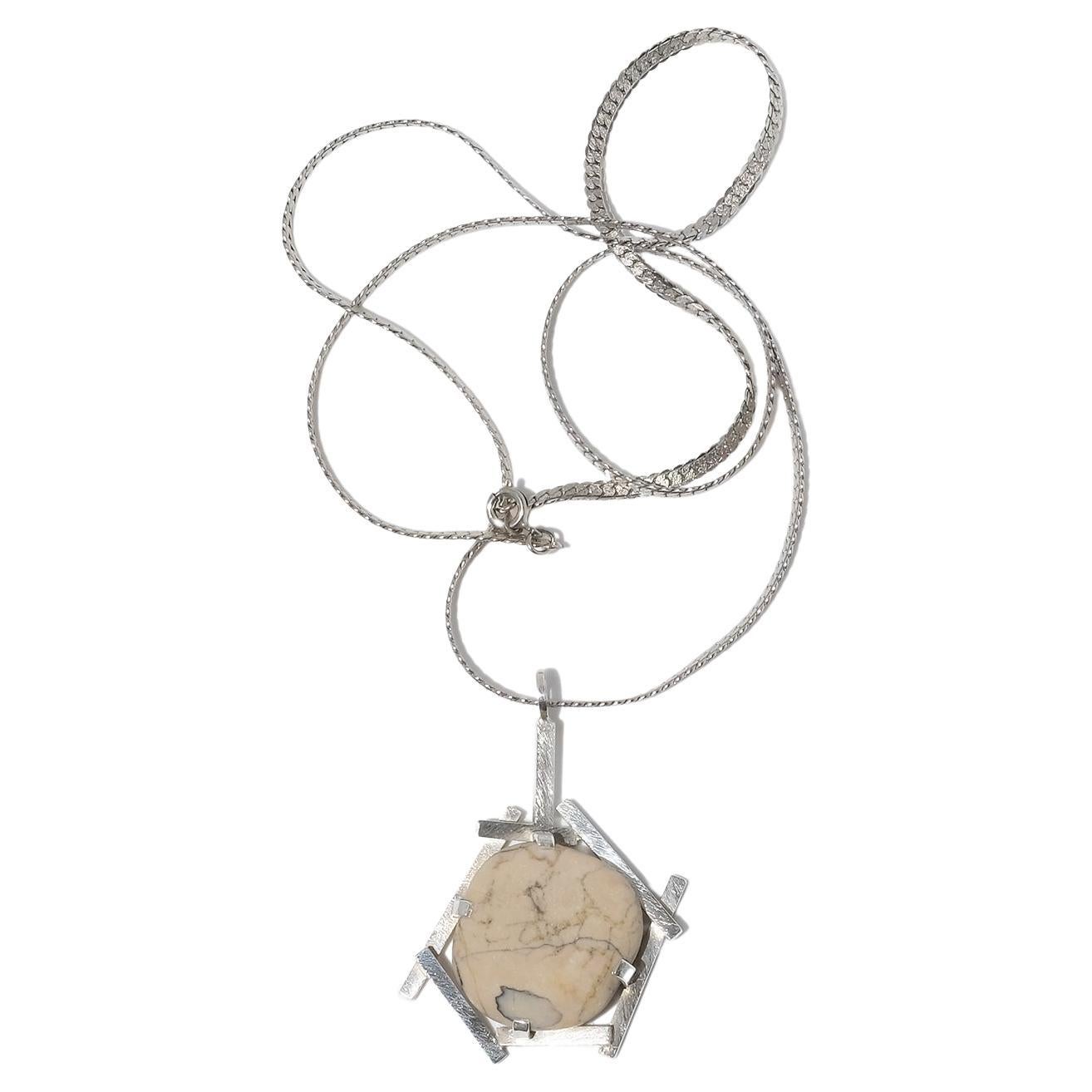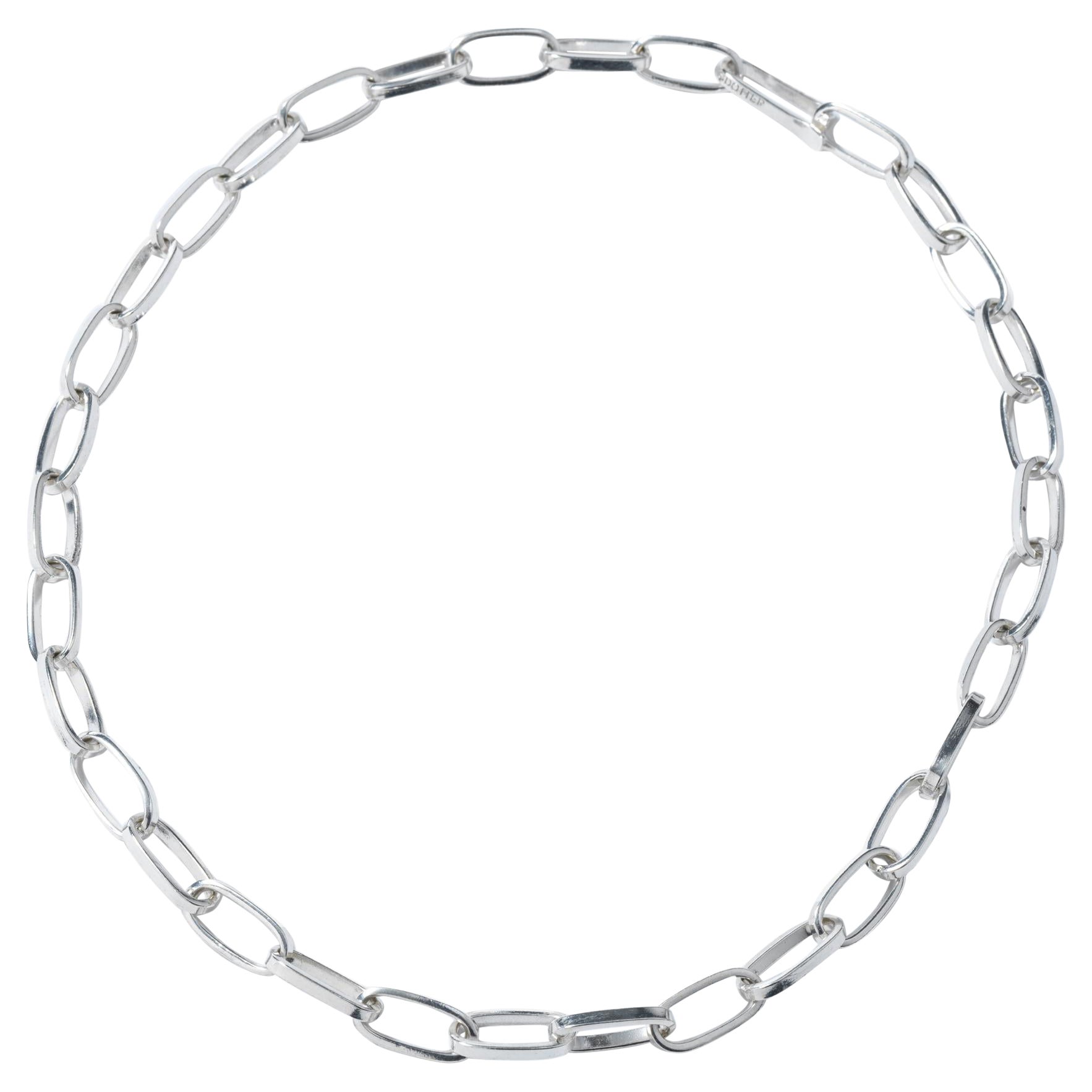Items Similar to Necklace Made by Wiwen Nilsson in 1938, Sweden
Want more images or videos?
Request additional images or videos from the seller
1 of 17
Necklace Made by Wiwen Nilsson in 1938, Sweden
About the Item
This sterling silver necklace shows upon typical Wiwen Nilsson characteristics; the geometric lines, the clean-cuts, the modern design and brushed silver, the square faceted cut rock crystals and the ring and bar chain.
The only way to describe this item in a relevant way is to call it wearable art.
This necklace will add the final touch to any outfit; a perfect fit for any social event and if you do not mind being seen, the strict job wardrobe.
Did you know that Wiwen Nilsson was the designer that introduced the cross as a fashion piece of jewelry in the 1930s?
Chain lt. 56 cm, pendant ht. 5,5 cm, wd. 3,3 mm, wt. 45 gm
- Creator:
- Metal:
- Stone:
- Stone Cut:
- Weight:45 g
- Dimensions:Length: 22.05 in (560 mm)
- Place of Origin:
- Period:
- Date of Manufacture:1938
- Condition:Wear consistent with age and use.
- Seller Location:Stockholm, SE
- Reference Number:1stDibs: LU2708217590492
About the Seller
5.0
Vetted Seller
These experienced sellers undergo a comprehensive evaluation by our team of in-house experts.
1stDibs seller since 2022
67 sales on 1stDibs
Typical response time: 1 hour
- ShippingRetrieving quote...Ships From: Stockholm, Sweden
- Return PolicyA return for this item may be initiated within 3 days of delivery.
More From This SellerView All
- Silver Necklace with Rock Crystal Cross, Made by Wiwen Nilsson in 1939, SwedenBy Wiwen NilssonLocated in Stockholm, SEThis sterling silver necklace shows upon typical Wiwen Nilsson characteristics; the pendant which is shaped as a Greek cross with square rock crystals, and the ring and bar chain. ...Category
Vintage 1930s Swedish Chain Necklaces
MaterialsRock Crystal, Silver
- Silver Brooch Made 1938 by Wiwen Nilsson, SwedenBy Wiwen NilssonLocated in Stockholm, SEThis brooch is shaped as a monogram of the letters G and N, but this arty design may be worn by anyone. The brooch has a unique shape and size and will easily go with any jacket, blo...Category
Vintage 1930s Swedish Brooches
MaterialsSilver
- Swedish Silver Bracelet by Wiwen Nilsson, Made 1942By Wiwen NilssonLocated in Stockholm, SEThis sterling silver bracelet has a ring and bar chain, which is adorned with a silver charm in the shape of a dice. This bracelet fits well in both an everyday environment as well...Category
Vintage 1940s Swedish Chain Bracelets
MaterialsSilver
- Pair of Swedish Cufflinks Made by Wiwen Nilsson in 1973By Wiwen NilssonLocated in Stockholm, SEThese gilded sterling silver cufflinks are rectangular shaped. The surface is matte and adorned with a monogram in releif. The monogram resembles an "à la grecque" pattern, that allo...Category
Vintage 1970s Swedish Cufflinks
MaterialsSilver
- Pair of Silver Cufflinks Made by Wiwen Nilsson, Sweden in 1961By Wiwen NilssonLocated in Stockholm, SEThese sterling silver cufflinks have a rectangular shape and a polished surface. The shape of the cufflinks are classic and their appearance can be described as simple but yet sophis...Category
Vintage 1960s Swedish Cufflinks
MaterialsSilver
- Silver Brooch with Rock Crystal Made 1946 by Wiwen Nilsson, SwedenBy Wiwen NilssonLocated in Stockholm, SEThis silver brooch is adorned with three faceted rock crystals. It is fastened easily with a trombone clasp, which were commonly used in jewelery made in the 1940s. The brooch has a...Category
Vintage 1940s Swedish Brooches
MaterialsRock Crystal, Silver
You May Also Like
- 1937 Art Deco 85 carat rock crystal silver necklace by Wiwen NilssonBy Wiwen NilssonLocated in Malmö, SESilver and approx 85ct rock crystal. Signed and dated 1937. The pendant is 6,7 cm long on a 59 cm long chain. Wiwen Nilsson (1897-1974) - An Art Deco Silversmith in the Age of Modernism. Wiwen Nilsson was born in Copenhagen, Denmark in 1897. Born as Karl Edvin, but since he did not like his christening name, he was, within the family, called Wiwen. He was the son of Karolina and Anders and grew up with his sister Edith. In 1897 the family moves to Lund, Sweden when the father takes over the gold and silversmith company J.P. Hasselgren & Son. In 1906, Wiwen began at Katedralsskolan in Lund and finished school when he graduated fifth grade in 1912. It was common to continue up to sixth grade and then high school, but Wiwen who does not thrive in a school environment wants to become a pianist or aviator instead. However, as the father is a recognized jeweler and court supplier, the son's career is already marked. Instead, he embarks on an educational journey with the goal Königliche Zeichenakademie in Hanau am Main, Germany. The school is Germany's oldest and most prestigious goldsmith's school. Wiwen enrolled on the fourth of August in 1913 and studied drawing, workshop work, engraving and hammering work. The education comes to an abrupt end with the outbreak of the First World War in 1914, and he instead continues his education in his father's workshop, where he stays until 1919. He does, however, make two breaks, the first quarter of 1917 he enrolled at the Technical Society's School in Copenhagen where he studied modeling, among other things, and in 1917-1918 he did his military service in Stockholm. In 1919 he applied for and received his companion letter, at the same time he received the Swedish Craft Organization's large medal in silver for his professionalism. In 1920 he is again at the school in Hanau, Germany where he stays until 1921 and practices with the jewelry company Chr. Kissling also in Hanau. At school, he mainly studies drawing and chiseling, a type of relief technique that was very popular during the 17th century. Wiwen is driven by his own design language and thinks that the prevailing technique under the influence of Danish designers is a setback in the development of chiseling. During his time in Hanau, he visits several arts and craft exhibitions and comes into contact with the Wiener Werkstätte and the Wiener Werkbund, among others. At the same time as he is studying, he writes travel stories where it emerges that he believes that Sweden's conservatism inhibits the development of arts and crafts, something he himself wants to change. Back in Sweden in 1921, he was appointed the company's artistic designer. In 1923, the company participates in the Gothenburg exhibition, but here Wiwen receives devastating criticism. His creations are considered ugly and meaningless, a critic writes that it is a typical case of poor material sense. In 1924, Wiwen Nilsson travels to Paris. Just like in Hanau, he studies chiseling, silver, drawing and modeling at the Académie de la Grande Chaumiére (now Académie Charpentier). One of France's foremost art schools where, among others, Siri Derkert (1888-1973) and Bror Hjorth (1894-1968) have also studied. In Paris he became acquainted with Georg Jensen (1866-1935), in whose workshop he chiseled for a period. He also meets and hangs out frequently with Jules Schyl (1893-1977) and Gösta Adrian-Nilsson, GAN (1884-1965). The meeting with GAN becomes extremely important and came to influence and refine Wiwen's own design language and together they hold a joint exhibition in 1925 in Lund. From 1925 until the end of the 1920s, Wiwen Nilsson produces a large amount of church silver. He designs and manufactures for, among others, Allhelgonakyrkan in Lund, Knästorps and Tottarps kyrka in Skåne. In total, Wiwen's workshop manufactures 677 objects for churches, of which 483 are found in churches within the diocese of Lund and 194 in other Swedish churches. Some are also sent internationally to the Church of Sweden in Paris, Berlin, Copenhagen and churches in West Germany, Iceland and to Zululand in South Africa. His church silver unmistakably bears the same design language as his profane works. All with the same angular but harmonized and modernist shapes, not infrequently his vessels like jugs and lid boxes are often hexagonal or octagonal. In 1925 he participated in the Exposition Internationale des Arts Décoratifs et Industriels à Paris (World Exhibition) where he received a gold medal in Class 10, the category for crafts and art industry in metal. Other exhibitors included C.G. Hallbergs Guldsmeds AB and Jacob Ängman...Category
Vintage 1930s Swedish Art Deco Pendant Necklaces
MaterialsRock Crystal, Silver
- Wiven Nilsson Necklace 14k 925 Silver & Druzy PyriteLocated in Montreal, QCSwedish Wiven Nilsson necklace pendant, 14k 925 silver, pearl and druzy pyrite. Marked inside the loupe, chain measures 15 inches long and the pendant 40mm in diameter. Pearl 9mm.Category
Late 20th Century Swedish Pendant Necklaces
MaterialsPyrite, Druzy, Silver, Gold
- 18 Karat Yellow Gold, French Made 'Love' NecklaceLocated in Brisbane, QLDThis sweet French necklace features a central plaque spelling 'love' and has been crafted from 18 karat yellow gold. The fine chain necklace centres on an oval yellow gold plaque tha...Category
20th Century French Modern Chain Necklaces
MaterialsGold, 18k Gold, Yellow Gold
- Trio Necklace in 18 Karat Yellow Gold by Allison BryanBy Allison BryanLocated in London, GBFeaturing our signature Paper texture on three tiny disc pendants, the trio necklace is crafted in solid 18-carat yellow gold. The pendants are strung on a delicate 16-inch 18-carat ...Category
2010s British Pendant Necklaces
MaterialsCitrine, Diamond, White Diamond, Yellow Diamond, Black Diamond, Brown Di...
- Diamond Palm Pendant Necklace in Solid Gold by Allison BryanBy Allison BryanLocated in London, GBThis delicate, sparkling pendant necklace features five white diamonds graduated in size to emphasise the organic, leaflike shape of the pendant. Each diamond is H color, VS1 clarit...Category
2010s British Pendant Necklaces
MaterialsDiamond, Citrine, Emerald, Sapphire, Topaz, Tourmaline, Turquoise, Padpa...
- Trio Necklace in 18 Karat Yellow Gold by Allison BryanBy Allison BryanLocated in London, GBFeaturing our signature Paper texture on three tiny disc pendants, the trio necklace is crafted in solid 18-carat yellow gold. The pendants are strung on a delicate 16-inch 18-carat ...Category
2010s British Pendant Necklaces
Materials18k Gold
Recently Viewed
View AllMore Ways To Browse
Chain Cross Necklace
Rock And Chain
Rock Vintage Fashion
Vintage Cross And Chain
Modern Sterling Chain Necklace
Silver Chain And Cross
Vintage Sterling Chain Necklaces And Pendants
Vintage Sterling Silver Chain Necklaces And Pendants
Swedish Modern Ring
Vintage Cut Crystal Necklace
Geometric Wardrobe
Vintage 1930s Wardrobe
Geometric Modern Necklace
1930 Silver Necklace
Square Cut Cross
Square Rock Crystal
Sterling Rock Necklace
Vintage Sterling Silver Cross
